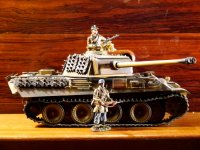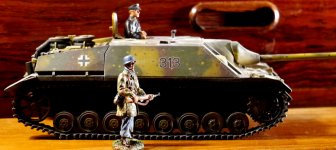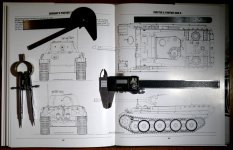
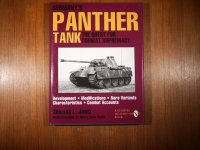
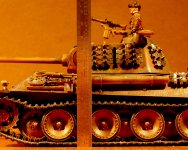
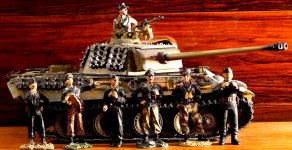
The first photo shows measuring instruments on top of a superb scale engineering drawing of a Panther G in 1/32 scale by Hilary Doyle.
The second photo shows the the cover of Germanys Panther Tank by T. L. Jentz. Published by Schiffer Military History 1995. The Hilary Doyle scale drawings are from this excellent book.
The third photo shows a measurement of the height of the Figarti Panther G.
The fourth photo shows a group of figures in increasing size from left to right. The first figure is 60mm tall above the base. The third figure from the left is the figure that came with the Figarti Panther G. The fourth figure from the left is by TCS and is 68 mm tall above the base.
The measurement of models is important in determining the scale. I wish manufacturers would produce their products to a true 1/30 scale; but alas they do not. The Figarti Panther G is a case in point. The box claims it is 1/30 scale; measurement proves it is 1/29 scale. Too large for 60 mm figures and too small for 68 mm figures.
Measurement of models can be complicated by the amount of misinformation on the dimensions of the actual vehicle. Accurate data sources are essential. Hilary Doyle actually measured the Panzers in museums to assure accuracy; rather than depend upon historical information often in error. I always try to find at least three sources that are in agreement to validate any data.
Calculating scale is simple. Divide the actual length, width or height of the Panzer by the models length, width or height in mm or inches. The result is the scale.. Example, the width of a Panther G is 129". The width of a Figarti Panther G is 4.375". 129/4.375=29.4 or 1/29 scale. A true 1/30 scale Panther can also be derived by the same equation i.e. 129/30=4.3. The correct width for a 1/30 scale Panther G is 4.3 inches.
I have read posts that have said scale is unimportant in Toy Soldiers. I can agree with that statement as long as you are not trying to produce a realistic scene or diorama; where relative sizes between vehicles, buildings and figures is essential. I have read posts where it has been said that the height of the Panzer is not relevant to calculating scale. I would agree if you are using 2 dimensional models; but the Toy soldier model are 3 dimensional and Panzer height is very important in determining the compatibility of the figures used in a scene or diorama. The validity of this can easily be proven by determining which figure standing next to the Figarti Panther G looks most realistic.







